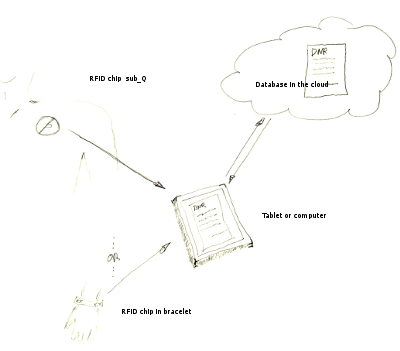Electronic Do Not Resuscitate
February 9/2018
This is a system that could be used to verify the legal intentions of an accident or unconscious victim where emergency CPR or other life saving activities are being refused.
I heard a story recently on NPR about a gentleman who had "Do Not Resuscitate" and his signature tattooed on his chest. The story ran on January 21/18. The man was left to die, but because the paperwork to back the tattoo was not readily available, an ethicist was called in to make the decision. Later, after the man passed, the paperwork was retrieved confirming the man's wishes.
The story went on to opine that it would be "What would really be helpful is an easy way to access official forms from everywhere. Ideally, EMTs and ER docs could both know instantly what care an unconscious person wants."
This got me thinking. I myself will most likely consider a DNR in the near future. I figure when I reach my mid seventies I will have lived a fairly full life. The act of CPR and its consequences, i.e. broken ribs, oxygen starvation, etc. may prove to be worse than passing.
My idea came to me one night as I lay in bed waiting for sleep to envelope me. Why not implant an RFID device subcutaneously above the left breast underneath a small tattoo? The RFID, similar to a chip used with pets, would contain a decryption key. This key would then be used to decrypt a retrieved copy of the signed DNR from a database. The intention would be fast and clear.
I discussed this with my good friend Larry. He suggested that not everyone using this system would want to be chipped in the manner I just described. He said maybe a bracelet with the same embedded chip would be made available. Brilliant!
I imagined that an EMT would have an application on their tablet that would scan for the RFID device, connect to the cloud to retrieve the DNR form. See Figure : eDNR.

An EMT or emergency doctor on the scene would see the tattoo or bracelet and would know to scan for the RFID. Once scanned, the tablet or computer then would access a cloud based database for the DNR on file. The DNR would be sent back to the EMT or doctor, decrypted and presented to the EMT or doctor. The intention is clarified and the emergency personnel would act accordingly.
There are registries already exist in Oregon and California. Quick access is key and I think something along the lines outlined would help the front line EMTs and doctors. I don't believe the system is totally foolproof, but I do think that this is a couple of steps closer to a failsafe system.

